Introduction
I’ve always been fascinated by how different fabrics impact the feel and functionality of clothing. One fabric that stands out, especially in polo shirts and sportswear, is piqué fabric. With its distinct textured surface and breathable nature, it’s a go-to choice for many garments, but what exactly makes piqué special?
Whether you’re a fashion designer, fabric enthusiast, or simply curious about textile choices, understanding piqué fabric’s structure, advantages, and applications can help you make better fabric selections.
What You’ll Learn in This Guide
- What is piqué fabric and how it’s made
- The key benefits of piqué fabric
- How piqué compares to other fabrics like jersey and cotton
- The best uses for piqué fabric in clothing and home textiles
What is Pique Fabric?
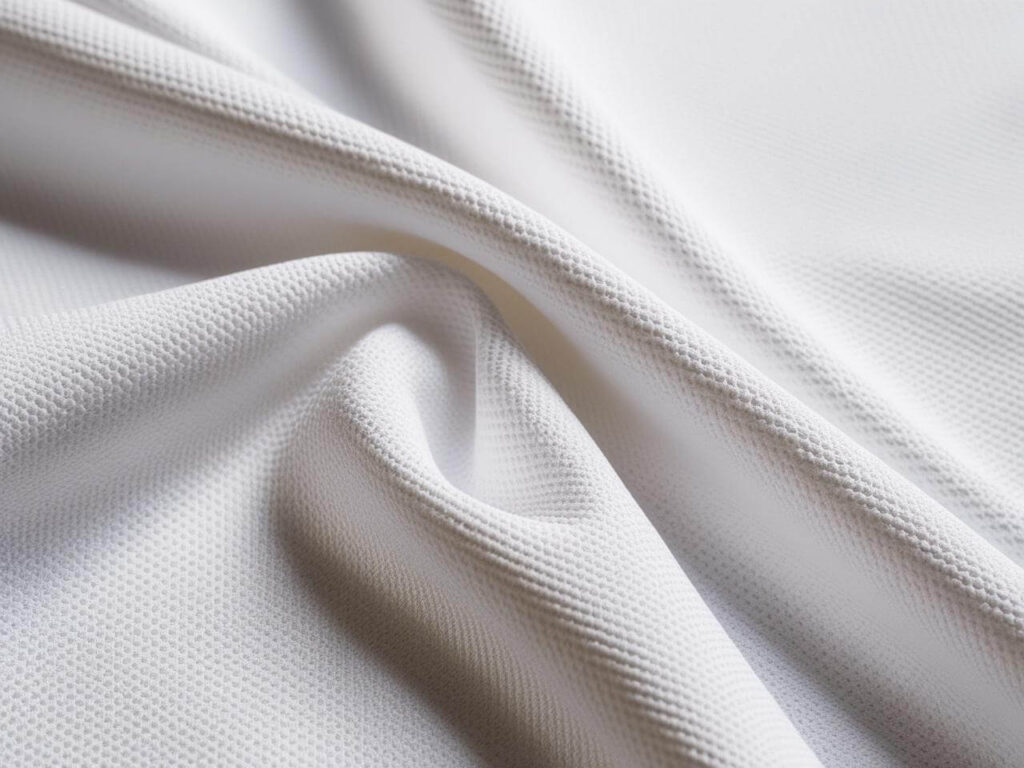
Piqué fabric is a knitted or woven textile known for its raised, waffle-like texture. This unique structure is achieved through a special weaving or knitting technique that creates small geometric patterns, making it breathable, durable, and stylish.
📌 Origins and History
- Developed in the 18th century in England, piqué fabric was initially crafted using a quilting technique.
- It gained popularity in formalwear and later in sportswear, thanks to its structured look and functional benefits.
- Today, piqué is most commonly associated with polo shirts, as pioneered by René Lacoste in the 1920s.
📌 Common Materials Used
Piqué fabric is primarily made from cotton, but there are also blends with polyester, spandex, and other synthetic fibers to enhance its performance.
| Material | Properties | Common Uses |
| Cotton Piqué | Soft, breathable, absorbs moisture | Polo shirts, casualwear |
| Polyester Piqué | Wrinkle-resistant, lightweight, quick-dry | Sportswear, athletic uniforms |
| Blended Piqué | Combines cotton & polyester benefits | Uniforms, everyday apparel |
Characteristics of Pique Fabric
Piqué fabric stands out due to its textured surface, breathability, and durability, making it a preferred choice for polo shirts, sportswear, and casual clothing. Here’s a closer look at its key characteristics:

📌 1. Textured & Structured Appearance
- The most defining feature of piqué fabric is its waffle-like or honeycomb texture, created through a double-weaving or knitting technique.
- This structure adds depth and rigidity, making it look more formal compared to smoother fabrics like jersey.
📌 2. Breathability & Moisture Control
- The textured weave creates small air pockets, enhancing ventilation and making it ideal for hot climates.
- Cotton piqué absorbs moisture well, while polyester piqué is designed to wick sweat away, keeping the wearer dry.
📌 3. Durability & Wrinkle Resistance
- The double-knit or woven construction makes it more durable than standard cotton or jersey fabrics.
- It resists wrinkles, making it a low-maintenance option for daily wear.
📌 4. Comfort & Stretch
- Cotton piqué is naturally soft and comfortable, while blended versions with spandex offer additional stretch for flexibility.
- It holds its shape well, making it a structured yet comfortable choice for casual and formalwear.
How is Pique Fabric Made?
The manufacturing process of piqué fabric plays a key role in its unique texture, durability, and functionality. It can be produced through weaving or knitting, depending on the intended use.
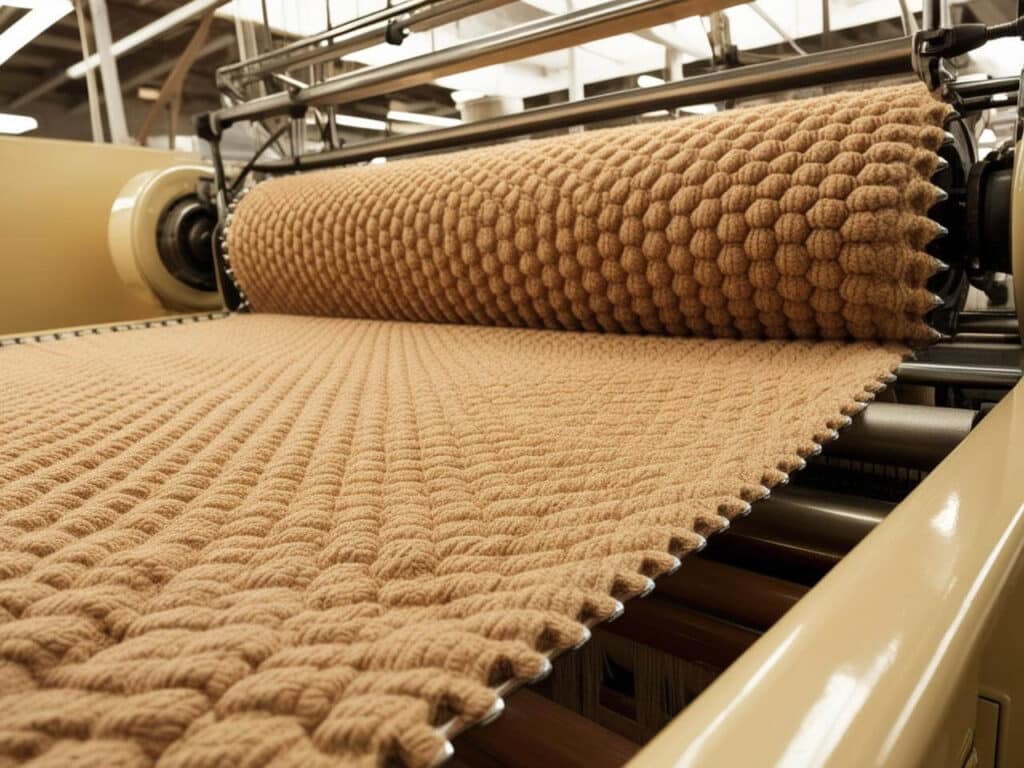
📌 1. Weaving vs. Knitting Techniques
| Method | Process | Common Uses |
| Woven Piqué | Created using a dobby loom, forming raised patterns | Dress shirts, upholstery, formalwear |
| Knitted Piqué | Produced with a double-knit process, adding stretch and breathability | Polo shirts, sportswear |
- Woven piqué is more structured and often used for formal clothing and upholstery.
- Knitted piqué, which is more flexible, is commonly found in polo shirts and athletic wear.
📌 2. Types of Piqué Fabric
There are several variations of piqué fabric, each offering different aesthetics and performance benefits:
| Type | Texture & Features | Best Uses |
| Birdseye Piqué | Small, diamond-shaped texture, fine weave | Dress shirts, uniforms |
| Double Piqué | Thicker, with extra layers for durability | Polo shirts, outerwear |
| Mini Piqué | Finer texture with a subtle raised pattern | High-end fashion, casualwear |
📌 3. Finishing & Treatment
To enhance durability and performance, piqué fabric often undergoes special treatments, such as:
- Moisture-wicking finish (for activewear)
- Wrinkle resistance (for easy-care clothing)
- Colorfast dyeing (for long-lasting vibrancy)
Uses & Applications of Pique Fabric
Piqué fabric’s unique texture, durability, and breathability make it a versatile material across multiple industries. It is widely used in fashion, sportswear, and home textiles.
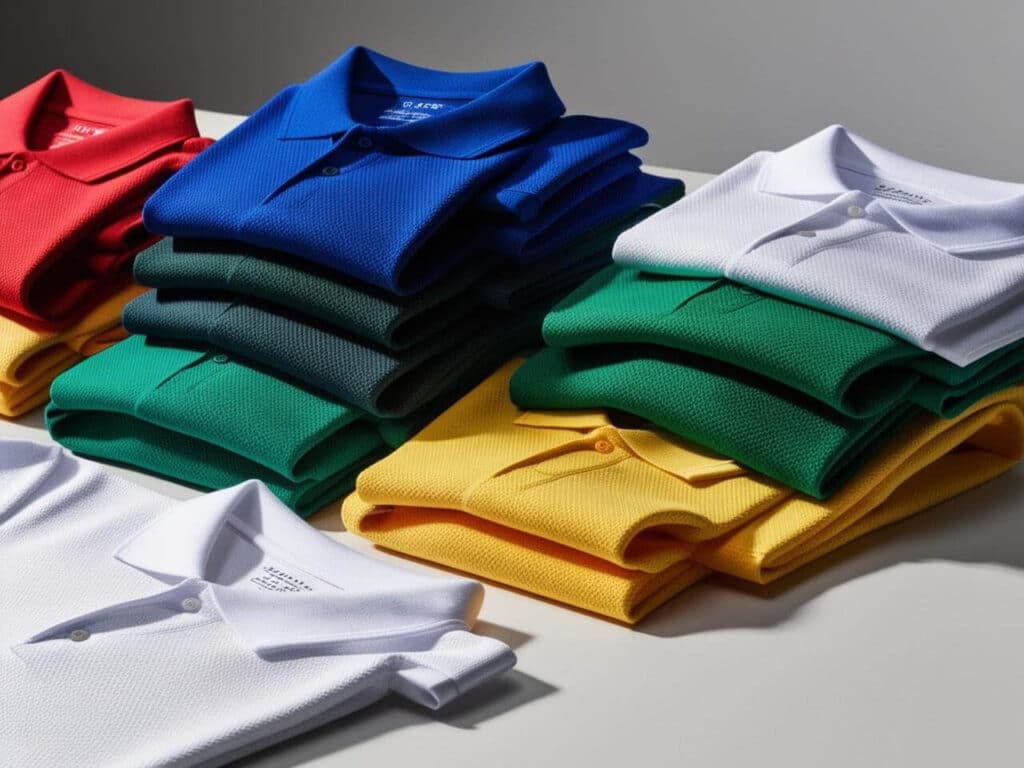
📌 1. Clothing Industry
Piqué fabric is most commonly associated with polo shirts, but it’s also used in a variety of other apparel items:
| Garment | Why Piqué is Used |
| Polo Shirts | Provides a structured yet breathable feel |
| Sportswear | Wicks moisture, keeps athletes cool |
| Casual & Dress Shirts | Adds texture and sophistication |
| Uniforms | Durable, wrinkle-resistant, professional look |
✅ Polo shirts, introduced by René Lacoste in the 1920s, remain the most iconic piqué fabric product, offering comfort, durability, and elegance.
📌 2. Home & Upholstery Uses
Beyond clothing, piqué fabric is also found in home textiles due to its durability and textured appeal:
| Application | Why Piqué Works Well |
| Bedding & Pillow Covers | Textured surface adds elegance and comfort |
| Curtains & Drapery | Structured fabric holds shape well |
| Upholstery | Durable and resistant to wear and tear |
📌 3. Functional & Specialty Uses
With advancements in textile technology, specialized piqué fabrics are now used for moisture-wicking sportswear, anti-wrinkle uniforms, and eco-friendly textiles.
Pique Fabric vs Other Fabrics
To better understand piqué fabric, let’s compare it with other popular textiles in terms of texture, breathability, durability, and best applications.
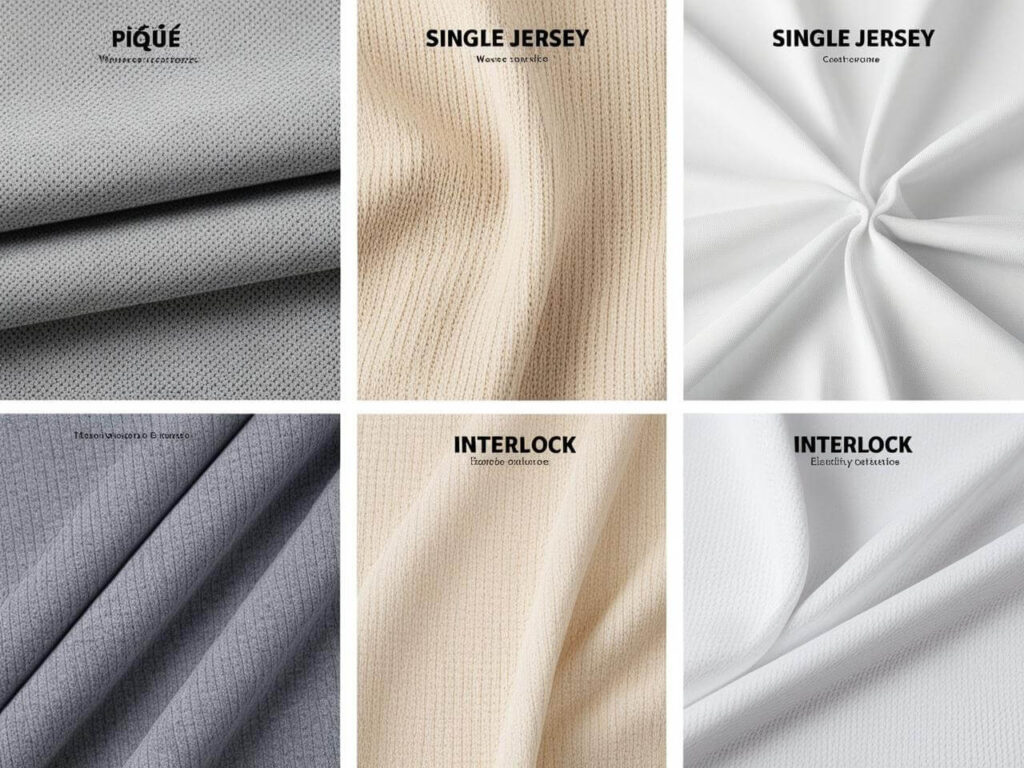
📌 1. Piqué vs. Single Jersey
| Feature | Piqué Fabric | Single Jersey Fabric |
| Texture | Textured, waffle-like weave | Smooth, flat knit |
| Breathability | High (due to air pockets) | Moderate |
| Durability | More structured, holds shape well | Soft, but stretches more easily |
| Best For | Polo shirts, sportswear | T-shirts, casualwear |
✅ Key Takeaway: Piqué is more structured and breathable, whereas single jersey fabric is softer and more form-fitting.
📌 2. Piqué vs. Cotton
| Feature | Piqué Fabric | Cotton Fabric |
| Material Composition | Cotton or cotton-blend | 100% natural cotton |
| Feel & Comfort | More textured, slightly rigid | Soft and smooth |
| Moisture Absorption | Moderate (woven texture helps) | High (pure cotton absorbs moisture well) |
| Common Use | Polo shirts, sportswear | T-shirts, casualwear, bedding |
✅ Key Takeaway: While both fabrics are comfortable, piqué fabric offers more texture and structure, whereas cotton is softer and absorbs moisture better.
📌 3. Piqué vs. Interlock
| Feature | Piqué Fabric | Interlock Fabric |
| Knit Type | Single-knit or double-knit | Double-knit (denser, smoother) |
| Elasticity | Low to moderate | High stretchability |
| Weight | Lightweight to medium weight | Heavier, thicker |
| Best For | Polo shirts, structured garments | Activewear, leggings, underwear |
✅ Key Takeaway: Piqué is structured and textured, while interlock is more elastic and thicker, often used for sportswear and stretch garments.
Pros & Cons of Pique Fabric
Like any textile, piqué fabric has its advantages and limitations. Here’s a breakdown of its pros and cons to help you determine if it’s the right fabric for your needs.
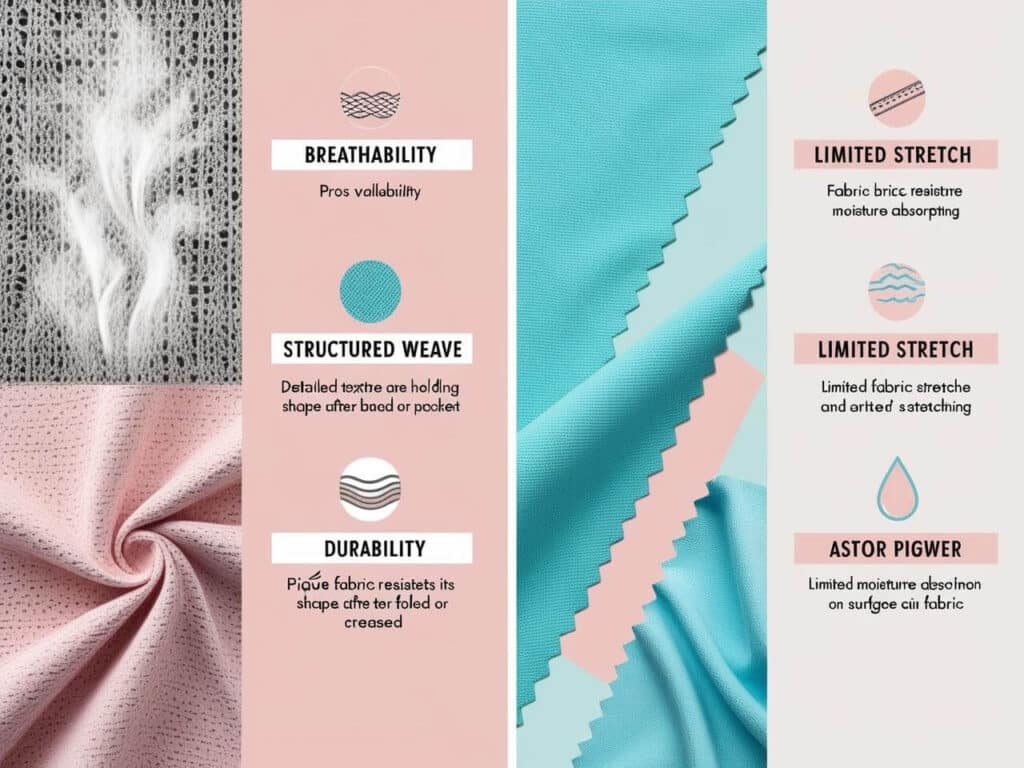
📌 1. Advantages of Pique Fabric
✅ Breathable & Moisture-Wicking – The textured weave creates air pockets, keeping the fabric cool and comfortable.
✅ Durable & Wrinkle-Resistant – Holds its shape well and resists creasing, making it ideal for daily wear.
✅ Elegant & Versatile – Offers a more sophisticated look than flat-knit fabrics, making it perfect for both casual and formalwear.
✅ Absorbs Sweat – Cotton piqué fabrics effectively absorb moisture, enhancing comfort.
✅ Holds Structure Well – Unlike jersey fabrics, piqué is less prone to sagging over time.
📌 2. Disadvantages of Pique Fabric
❌ Not as Soft as Jersey – The textured surface makes it slightly stiffer than smoother knits.
❌ Limited Stretch – Compared to interlock or spandex-based fabrics, piqué fabric has less elasticity.
❌ Absorbs Less Moisture Than Cotton – While breathable, it doesn’t absorb as much water as pure cotton, which can make it feel slightly damp in humid conditions.
❌ Requires Special Care for Longevity – Some piqué fabrics need gentle washing to maintain their texture and durability.
FAQs: Everything You Need to Know About Pique Fabric
To address common questions about piqué fabric, here are concise and informative answers optimized for search intent.
❓ Is pique fabric good for summer?
✔ Yes! Piqué fabric is highly breathable due to its textured weave, allowing air circulation. This makes it a great choice for summer clothing, especially polo shirts and sportswear.
❓ What is the difference between pique and jersey fabric?
✔ Piqué fabric has a raised, waffle-like texture, making it more structured and breathable.
✔ Jersey fabric is smoother, stretchier, and softer, making it better for T-shirts and casualwear.
❓ Is pique fabric always 100% cotton?
✔ Not necessarily. While many piqué fabrics are made from 100% cotton, some are blended with polyester or spandex to enhance durability, stretch, or moisture-wicking properties.
❓ Does pique fabric shrink after washing?
✔ Yes, if made from cotton, piqué fabric may shrink slightly after the first wash. To prevent excessive shrinkage, wash in cold water and air dry.
❓ What is piqué fabric best used for?
✔ Most commonly used for:
- Polo shirts
- Sportswear & golf shirts
- Dress shirts
- Upholstery & bedding
Final Thoughts: Why Piqué Fabric is a Great Choice
Piqué fabric stands out for its unique textured weave, breathability, and durability, making it a popular choice for polo shirts, sportswear, and even home textiles. Whether you’re looking for a structured, wrinkle-resistant fabric for professional wear or a moisture-wicking material for athletic clothing, piqué fabric offers a balance of style and functionality.
✔ Key Takeaways
✅ Breathable & Durable – Ideal for warm weather and activewear.
✅ Holds Shape Well – Less prone to sagging compared to softer knits.
✅ Versatile Use Cases – Found in casual, sports, and formal apparel.
✅ Available in Multiple Blends – Can be 100% cotton or mixed with synthetics for added performance.
If you’re considering piqué fabric for your next clothing project or wardrobe update, it’s a timeless and practical option that combines elegance with functionality.
